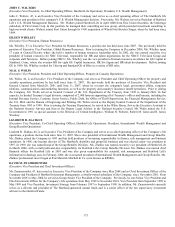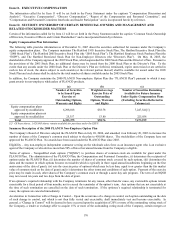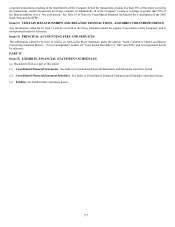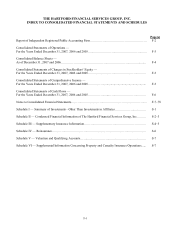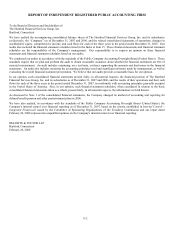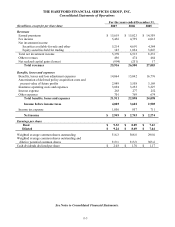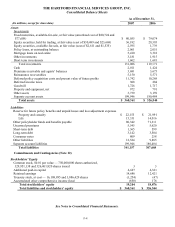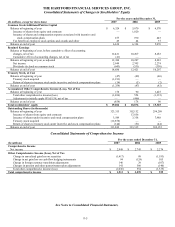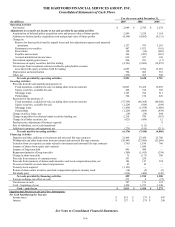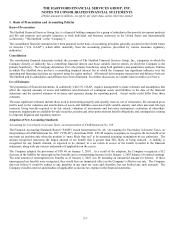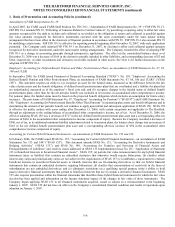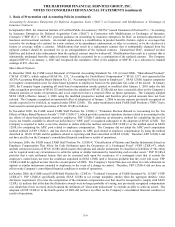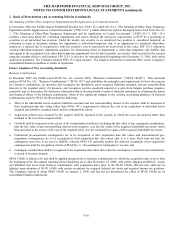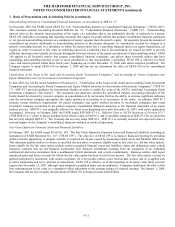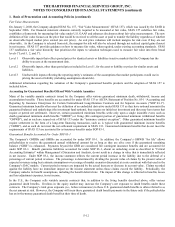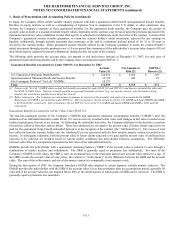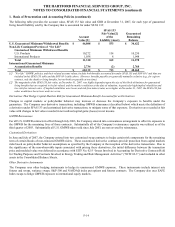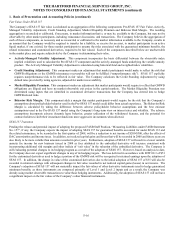The Hartford 2007 Annual Report Download - page 184
Download and view the complete annual report
Please find page 184 of the 2007 The Hartford annual report below. You can navigate through the pages in the report by either clicking on the pages listed below, or by using the keyword search tool below to find specific information within the annual report. F-7
THE HARTFORD FINANCIAL SERVICES GROUP, INC.
NOTES TO CONSOLIDATED FINANCIAL STATEMENTS
(Dollar amounts in millions, except for per share data, unless otherwise stated)
1. Basis of Presentation and Accounting Policies
Basis of Presentation
The Hartford Financial Services Group, Inc. is a financial holding company for a group of subsidiaries that provide investment products
and life and property and casualty insurance to both individual and business customers in the United States and internationally
(collectively, “The Hartford” or the “Company”).
The consolidated financial statements have been prepared on the basis of accounting principles generally accepted in the United States
of America (“U.S. GAAP”), which differ materially from the accounting practices prescribed by various insurance regulatory
authorities.
Consolidation
The consolidated financial statements include the accounts of The Hartford Financial Services Group, Inc., companies in which the
Company directly or indirectly has a controlling financial interest and those variable interest entities in which the Company is the
primary beneficiary. The Company determines if it is the primary beneficiary using both qualitative and quantitative analyses. Entities
in which The Hartford does not have a controlling financial interest but in which the Company has significant influence over the
operating and financing decisions are reported using the equity method. All material intercompany transactions and balances between
The Hartford and its subsidiaries and affiliates have been eliminated. For further discussions on variable interest entities see Note 4.
Use of Estimates
The preparation of financial statements, in conformity with U.S. GAAP, requires management to make estimates and assumptions that
affect the reported amounts of assets and liabilities and disclosure of contingent assets and liabilities at the date of the financial
statements and the reported amounts of revenues and expenses during the reporting period. Actual results could differ from those
estimates.
The most significant estimates include those used in determining property and casualty reserves, net of reinsurance; life estimated gross
profits used in the valuation and amortization of assets and liabilities associated with variable annuity and other universal life-type
contracts; living benefits required to be fair valued; valuation of investments and derivative instruments, evaluation of other-than-
temporary impairments on available-for-sale securities; pension and other postretirement benefit obligations; and contingencies relating
to corporate litigation and regulatory matters.
Adoption of New Accounting Standards
Accounting for Uncertainty in Income Taxes, an interpretation of FASB Statement No. 109
The Financial Accounting Standards Board (“FASB”) issued Interpretation No. 48, “Accounting for Uncertainty in Income Taxes, an
interpretation of FASB Statement No. 109” (“FIN 48”), dated June 2006. FIN 48 requires companies to recognize the tax benefit of an
uncertain tax position only when the position is “more likely than not” to be sustained assuming examination by tax authorities. The
amount recognized represents the largest amount of tax benefit that is greater than 50% likely of being realized. A liability is
recognized for any benefit claimed, or expected to be claimed, in a tax return in excess of the benefit recorded in the financial
statements, along with any interest and penalty (if applicable) on the excess.
The Company adopted the provisions of FIN 48 on January 1, 2007. As a result of the adoption, the Company recognized a $12
decrease in the liability for unrecognized tax benefits and a corresponding increase in the January 1, 2007 balance of retained earnings.
The total amount of unrecognized tax benefits as of January 1, 2007 was $8 including an immaterial amount for interest. If these
unrecognized tax benefits were recognized, they would have an immaterial effect on the Company’ s effective tax rate. The Company
does not believe it would be subject to any penalties in any open tax years and, therefore, has not booked any such amounts. The
Company classifies interest and penalties (if applicable) as income tax expense in the financial statements.



